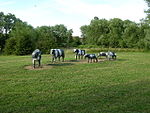Royal Train Shed
1889 establishments in EnglandBuildings and structures completed in 1889Buildings and structures in Milton KeynesGrade II listed buildings in BuckinghamshireLondon and North Western Railway ... and 1 more
Wolverton

The Royal Train Shed was part of the former Wolverton railway works in Milton Keynes, southern England. It was built in 1899 and changed use several times before it was used to house the British Royal Train from 1963 to 1991. The building has since been converted into residential use and is now a Grade II listed building.
Excerpt from the Wikipedia article Royal Train Shed (License: CC BY-SA 3.0, Authors, Images).Royal Train Shed
Earlestown Way, Milton Keynes Stonebridge
Geographical coordinates (GPS) Address Nearby Places Show on map
Geographical coordinates (GPS)
| Latitude | Longitude |
|---|---|
| N 52.0665 ° | E -0.8073 ° |
Address
Earlestown Way
MK12 5FH Milton Keynes, Stonebridge
England, United Kingdom
Open on Google Maps









